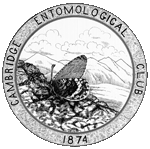
| January 2008: Psyche has a new publisher, Hindawi Publishing, and is accepting submissions |
Article beginning on page 54.
Psyche 3:54, 1880.
Full text (searchable PDF)
Durable link: http://psyche.entclub.org/3/3-054.html
The following unprocessed text is extracted from the PDF file, and is likely to be both incomplete and full of errors. Please consult the PDF file for the complete article.
CAMBRIDGE, MASS.. APKIL 1880.
Communisatwtis, exchanges ad editws' copies should be addressed ~OEDITOBS or PSYCHE. Camhrid#e, Mass Commu~{catww for publfwifort itt PSYCHE mi& be property auiheifticatwf,, and no anonymow articles will be pHflh7ieif.
fititwa and con<rSbuto?s art only respon3it)le far the statements mude in their own ~0fttmunfeatH)ns. Worlh on subjects not i*etVteiS to entoimioffy icfit sot be reviewed in FSTCHE.
For raif╠ of subsc~~pfion and of advertising, see aS- vwtiitifta wlicmfts.
PROCEEDINGS OS- SOCIETIES.
EKTOMOLOGlCA'L BBCT16S OF THE BOSTOK SO
CIETY OF NATURAL HISTORY.
28 JATS. 1880. -Mr. S : IT. Scudder showed some excellent drawings of fossil herniptern, made by J. E. Blake.-Dr. H. A. Hagen read an additional note upon the larva and fly sup- posed to have been token from a girl's uectt, in Toronto,and gave a list of the instances in which Surwphago had been found in the human body. He ftleo read a paper on the literature relating to galls. -Mr. E : Burgess dewriled the etruc- ture and physiology of a butterfly's proboscis. 25 FEB. 1880.-Mr. S: K. Scudder showed
some plates on which were figured all the foaail insects known from British Columbia, - Dr. H A. Hagen read a paper on the mouth of Nemo- gnorta, criticising Herrnann Muller's specnhtions on the development of the insect proboscis. Dr. Hagen discussed the results of Dr. Palmen's studies on the tracheal system of insects, de xribing his own views of the condition of the &igrnftta during pupation, &a,, md showed epeci- mew and A'nwings to illustrate' the respiratory apparatus of many water insects.-Mr. E: Bur- gem made further remarks on the stracture of the butterfly proboscis.
24 MAR. 1880, - Mr. E : Burgess showed under the microscope the structure and explained the workings of the pharyngeal bulb in the head of lepidoptera; he showed also the structure and arrangement of the muscles in the proboscis. E : PIC&MAA- MAKS, &crriary.
REVIEWS.
KATTEK'S INDEX EMTOBIOLOGICUS Pars K [gee Bee., no.18101 is a list of the entomologists of Europe as far as its author has been able to learn their nainea, together with their addresses, the departments of entomology to which they give their especial attention, and an indication of those desiring to exchange specimens. To the above is added a list, extracted from the %rd- ids' Directory (Salem, 1878), of 73 American col- lectors dc~iring to exchange, and a list of the entomological societies and publications of the world. Although the list is defective for coun- tries mtsicle of Germany, yet the following com- parison, basedaon a hasty count, not including the five pages of additions and errata, may Ie of interest. The entomologists and collectors enu- merated are
distributed as follows : Germany,
740; Austria, 213 ; Switzerland, 97 ; Holland, 84; Belgium, 93; Italy, 128; Spain, 19; Portu- gal, 2 ; Greece, 3 ; Roumda, 1 ; Russia, 58 ; Fin- land, 8 ; Sweden, 26 ; Norway, 2; Denmark, 4; England, 433 ; Scotland, 15 ; Ireland, 3; France (whose coleopterists are not included), 197 ; total, 21213. Of entomological societies, Europe is cred- ited with 17 ; America, 4, and Australia, 1. G: D.
BERNHARD GERHABIT'S catalog of the macro- lepidoptera of North America [see Rec., no. 15841 seems to have received but little notice at the hands of entomologists. Like most publications of its kind which have been compiled in localities distant from the land the fauna of which they enumerate, Gerhard's catalog is imperfect and incomplete in many particulars. This catalog a^aumeK to give the synonymy of our species, but contains the names of only 103 genera of rhspalocera out of over 150 names which may fairly be termed in modem UBG. It is useless to call attention to special errors, as our specice are SO well cataloged by American writers,
G: D,
================================================================================
Volume 3 table of contents